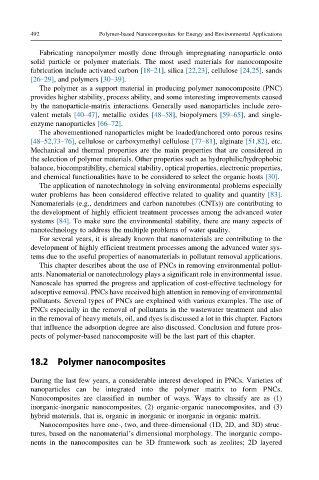Page 539 - Polymer-based Nanocomposites for Energy and Environmental Applications
P. 539
492 Polymer-based Nanocomposites for Energy and Environmental Applications
Fabricating nanopolymer mostly done through impregnating nanoparticle onto
solid particle or polymer materials. The most used materials for nanocomposite
fabrication include activated carbon [18–21], silica [22,23], cellulose [24,25], sands
[26–29], and polymers [30–39].
The polymer as a support material in producing polymer nanocomposite (PNC)
provides higher stability, process ability, and some interesting improvements caused
by the nanoparticle-matrix interactions. Generally used nanoparticles include zero-
valent metals [40–47], metallic oxides [48–58], biopolymers [59–65], and single-
enzyme nanoparticles [66–72].
The abovementioned nanoparticles might be loaded/anchored onto porous resins
[48–52,73–76], cellulose or carboxymethyl cellulose [77–81], alginate [51,82], etc.
Mechanical and thermal properties are the main properties that are considered in
the selection of polymer materials. Other properties such as hydrophilic/hydrophobic
balance, biocompatibility, chemical stability, optical properties, electronic properties,
and chemical functionalities have to be considered to select the organic hosts [30].
The application of nanotechnology in solving environmental problems especially
water problems has been considered effective related to quality and quantity [83].
Nanomaterials (e.g., dendrimers and carbon nanotubes (CNTs)) are contributing to
the development of highly efficient treatment processes among the advanced water
systems [84]. To make sure the environmental stability, there are many aspects of
nanotechnology to address the multiple problems of water quality.
For several years, it is already known that nanomaterials are contributing to the
development of highly efficient treatment processes among the advanced water sys-
tems due to the useful properties of nanomaterials in pollutant removal applications.
This chapter describes about the use of PNCs in removing environmental pollut-
ants. Nanomaterial or nanotechnology plays a significant role in environmental issue.
Nanoscale has spurred the progress and application of cost-effective technology for
adsorptive removal. PNCs have received high attention in removing of environmental
pollutants. Several types of PNCs are explained with various examples. The use of
PNCs especially in the removal of pollutants in the wastewater treatment and also
in the removal of heavy metals, oil, and dyes is discussed a lot in this chapter. Factors
that influence the adsorption degree are also discussed. Conclusion and future pros-
pects of polymer-based nanocomposite will be the last part of this chapter.
18.2 Polymer nanocomposites
During the last few years, a considerable interest developed in PNCs. Varieties of
nanoparticles can be integrated into the polymer matrix to form PNCs.
Nanocomposites are classified in number of ways. Ways to classify are as (1)
inorganic-inorganic nanocomposites, (2) organic-organic nanocomposites, and (3)
hybrid materials, that is, organic in inorganic or inorganic in organic matrix.
Nanocomposites have one-, two, and three-dimensional (1D, 2D, and 3D) struc-
tures, based on the nanomaterial’s dimensional morphology. The inorganic compo-
nents in the nanocomposites can be 3D framework such as zeolites; 2D layered

